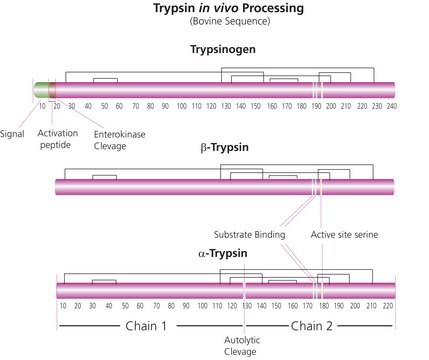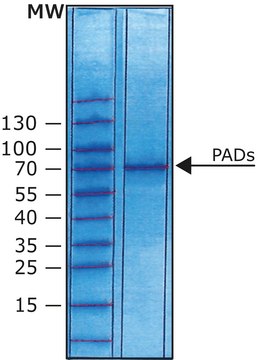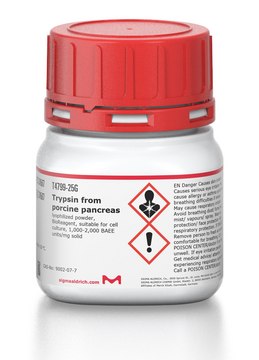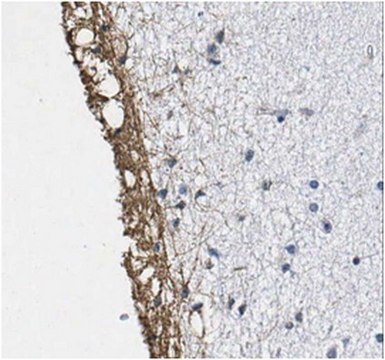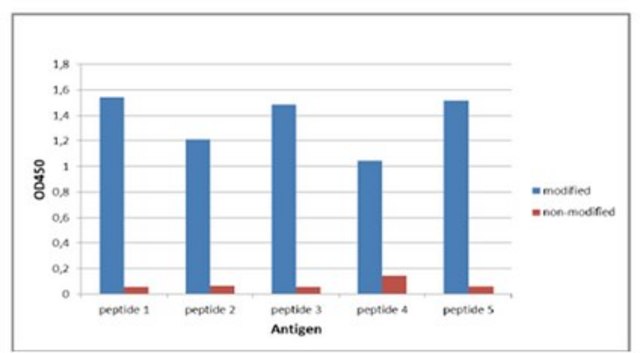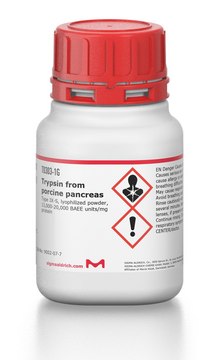Recommended Products
biological source
rabbit
Quality Level
antibody form
affinity isolated antibody
antibody product type
primary antibodies
clone
polyclonal
purified by
affinity chromatography
species reactivity
human, vertebrates, mouse
manufacturer/tradename
Upstate®
technique(s)
immunohistochemistry: suitable
western blot: suitable
isotype
IgG
shipped in
wet ice
target post-translational modification
unmodified
General description
The amino acid Citrulline is required to detoxify the liver from ammonia, which is a waste product of the body from oxidation. Citrulline promotes energy and assists with the immune system. This unusual amino acid is formed in the urea cycle by the addition of carbon dioxide and ammonia to ornithine. It is then combined with aspartic acid to form arginosuccinic acid, which later is metabolized into the amino acid arginine.
Specificity
Multiple deiminated keratins in human cornified skin. Thought to react preferentially with citrulline residues in glycine rich contexts.
Immunogen
Linear peptide containing Citrulline.
Application
Detect Citrulline with Anti-Citrulline Antibody (Rabbit Polyclonal Antibody), that has been shown to work in WB & IHC.
Research Category
Inflammation & Immunology
Inflammation & Immunology
Research Sub Category
General Post-translation Modification
General Post-translation Modification
Quality
routinely evaluated by immunoblot in whole cell lysates from tape-stripped human outer cornified layers
Target description
43-65 kDa
Physical form
25mM Tris/Tris-HCl, pH 7.4, 137mM NaCl,2.7mM KCl, 0.02% sodium azide before the addition of glycerol to 30%
ImmunoAffinity Purified
Storage and Stability
Stable for 1 year at 2-8°C from date of receipt.
Analysis Note
Control
Human outer cornified layer whole cell lysate
Human outer cornified layer whole cell lysate
Legal Information
UPSTATE is a registered trademark of Merck KGaA, Darmstadt, Germany
Disclaimer
Unless otherwise stated in our catalog or other company documentation accompanying the product(s), our products are intended for research use only and are not to be used for any other purpose, which includes but is not limited to, unauthorized commercial uses, in vitro diagnostic uses, ex vivo or in vivo therapeutic uses or any type of consumption or application to humans or animals.
WGK
WGK 1
Certificates of Analysis (COA)
Search for Certificates of Analysis (COA) by entering the products Lot/Batch Number. Lot and Batch Numbers can be found on a product’s label following the words ‘Lot’ or ‘Batch’.
Already Own This Product?
Find documentation for the products that you have recently purchased in the Document Library.
T Senshu et al.
Journal of dermatological science, 21(2), 113-126 (1999-10-08)
Citrulline residues are detected in keratins and filaggrin in the cornified layers of mammalian epidermis. Such citrulline residues are formed by the enzymatic deimination of arginine residues by peptidylarginine deiminases (EC 3.5.3.15). Major deiminated keratins are derived from keratin K1.
A Ishida-Yamamoto et al.
The Journal of investigative dermatology, 114(4), 701-705 (2000-03-25)
Citrulline-containing proteins, mainly originating from keratin K1 and formed by enzymatic deimination of arginine residues, have been identified in the cornified layers of human epidermis. We analyzed the localization and nature of the deiminated proteins in psoriatic epidermis. Immunostaining based
T Senshu et al.
Biochemical and biophysical research communications, 225(3), 712-719 (1996-08-23)
The upper layers of mammalian epidermis contain citrulline-containing proteins formed by enzymatic deimination of arginine residues. To study the role of protein deimination in epidermal differentiation, we identified deiminated proteins extracted from human epidermis. Major deiminated proteins were identified as
Akemi Ishida-Yamamoto et al.
The Journal of investigative dermatology, 118(2), 282-287 (2002-02-14)
The final step of keratinocyte differentiation, transition from the granular cells to the cornified cells, involves various post-translational modifications that include deimination of arginine residues. Major deiminated epidermal proteins are derived from K1. Two preferred deimination sites were identified in
Hans-Georg Kopp et al.
The Journal of clinical investigation, 116(12), 3277-3291 (2006-12-05)
Thrombopoietic cells may differentially promote or inhibit tissue vascularization by releasing both pro- and antiangiogenic factors. However, the molecular determinants controlling the angiogenic phenotype of thrombopoietic cells remain unknown. Here, we show that expression and release of thrombospondins (TSPs) by
Our team of scientists has experience in all areas of research including Life Science, Material Science, Chemical Synthesis, Chromatography, Analytical and many others.
Contact Technical Service